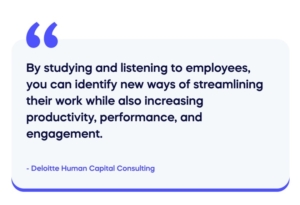Are your employees happy? Supported? Do they feel listened to when they communicate a personal challenge? All these concerns affect employee experience, so it’s helpful to consider these questions to retain staff and increase productivity.
However, with the increasing demands of employees, it can be costly and time-consuming to meet their needs continually. But an employee experience strategy helps direct resources in a structured way to ensure EX (employee experience) investment results in employee satisfaction, leading to higher performance and retention.
Because of the importance of providing a positive employee experience, we have covered the following topics to help you create an employee experience strategy in seven easy steps:
- What is an employee experience strategy?
- Who is responsible for the employee experience strategy?
- Why is employee experience strategy important?
- How to develop an employee experience strategy
What is an employee experience strategy?
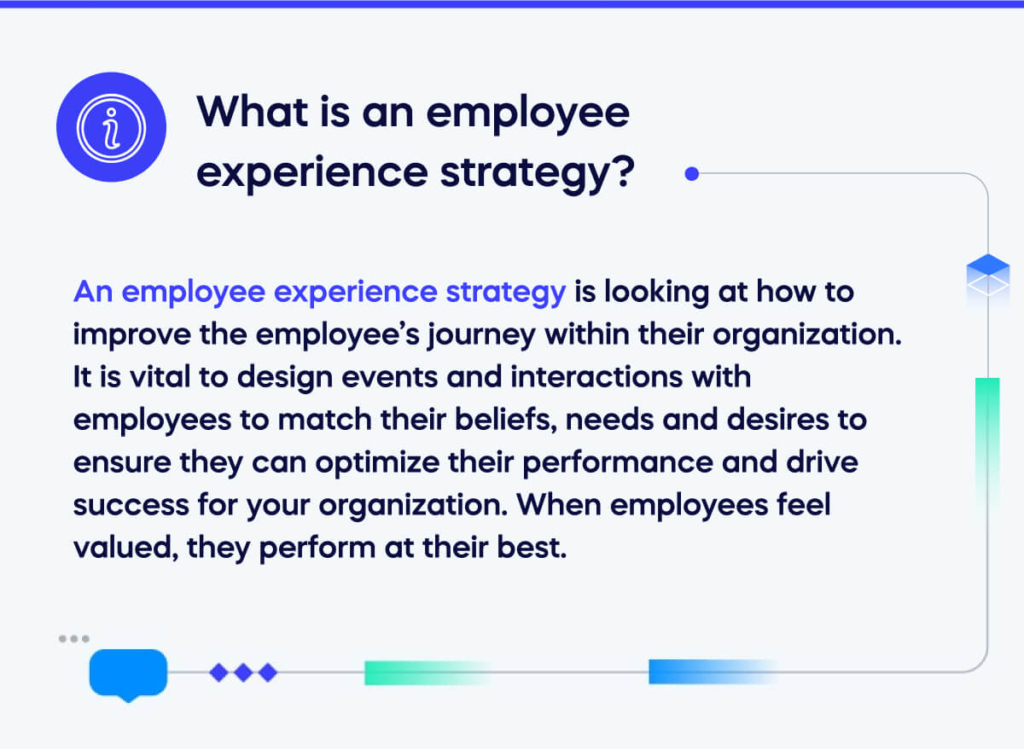
An employee experience strategy is looking at how to improve the employee’s journey within their organization. It is vital to design events and interactions with employees to match their beliefs, needs and desires to ensure they can optimize their performance and drive success for your organization. When employees feel valued, they perform at their best.
Who is responsible for the employee experience strategy?
Human Resources usually develops and implements the employee experience strategy through successful employee experience management. However, everyone in an organization is responsible for contributing and carrying out employee experience. Staff feedback is essential to ensuring an employee experience strategy works, and team managers must be aware of how important the strategy is to be available to receive and record feedback from staff on how to continually improve it.
Why is employee experience strategy important?
An employee experience strategy is important because it improves the employee experience, boosting retention, performance, and revenue. A 2022 Mercer study discovered that living wages, affordable healthcare, and retirement readiness were the top three employee concerns. Knowing and meeting these needs could encourage staff to remain at your organization, saving you vast resources as you maintain a healthy company culture.
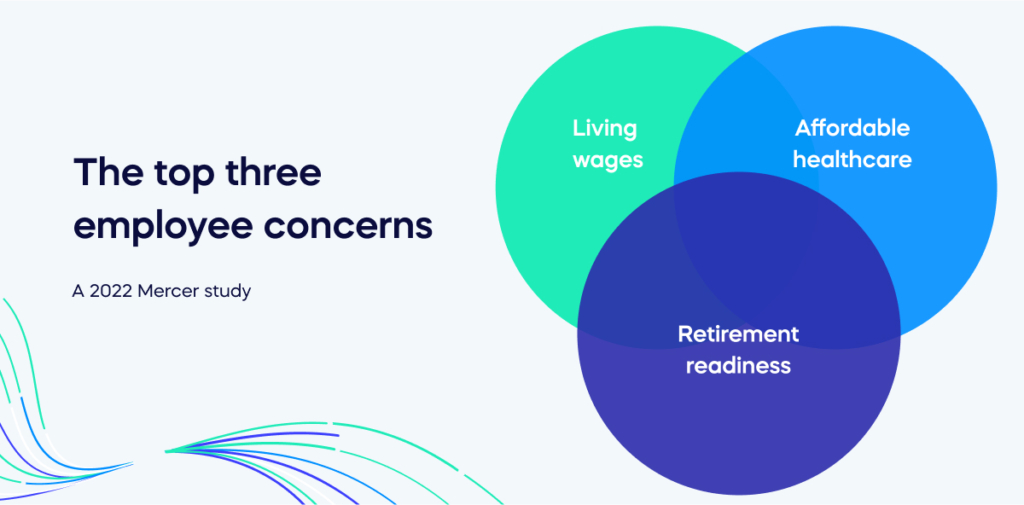
How to develop an employee experience strategy
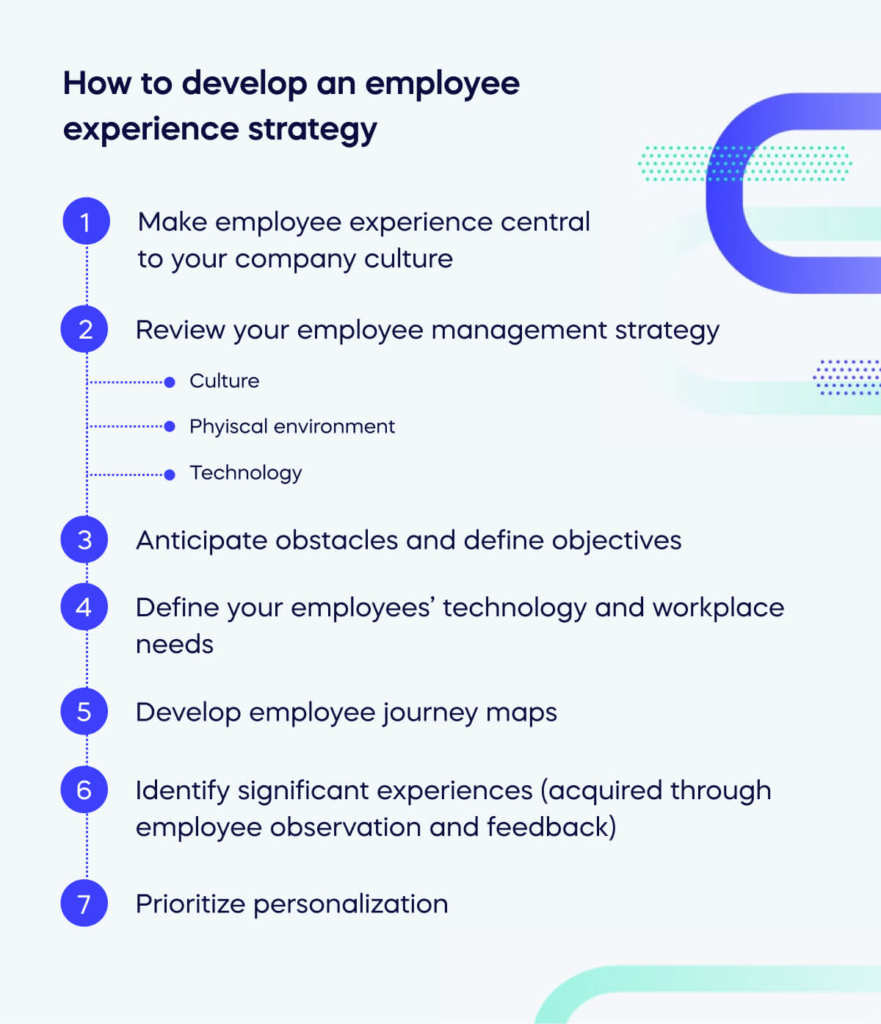
The first step to developing an employee experience strategy is to make employee experience central to your company culture. Gartner highlights this point by finding that only 13% of employees are satisfied with their employee experience. Dissatisfaction can lead to departures if not improved, and developing a robust employee experience strategy can help you to enhance employee experience, driving performance as the organization meets personalized needs.
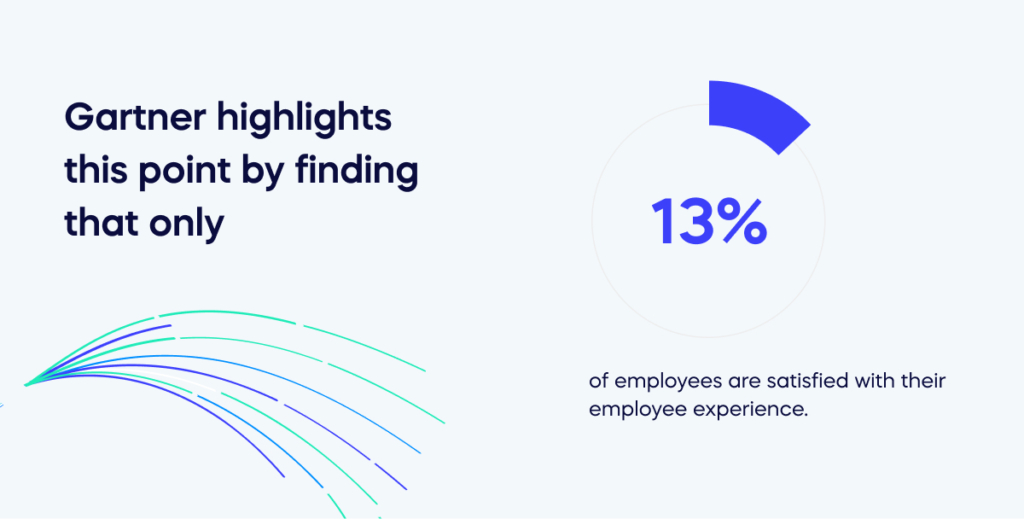
1. Make employee experience central to your company culture
To construct a successful employee experience strategy, it is paramount to bring in a human-centric approach as part of the organization’s culture and core values. From the employee onboarding process to offboarding, people should come first: understanding them as your most significant assets will be essential for creating an effective EX plan as you integrate it into your workplace culture.
2. Review your employee management strategy
The following step is to assess your current talent management plan. During this stage, it’s helpful to consider the three most pivotal EX aspects:
- Culture:The culture of a company, or what it feels like to work within an organization, is heavily influenced by its organizational structure, how leadership behaves and interacts with employees, employee compensation packages, and benefits plans.
- Physi+cal environment: Tangible items such as desks, chairs, office supplies, artwork, and food can be seen, heard, touched, or tasted. These impact employee experience in a big way as the sensory experience of the workplace.
- Technology: It’s important for employees to have the technological tools such as user interfaces and software to complete their tasks.
Consider these aspects of your employee management strategy to ensure you are meeting your staff needs.
3. Anticipate obstacles and define objectives
Once you have obtained feedback from your employees, use that data to pinpoint the underlying causes of negative experiences they may be having. By leveraging those insights, create objectives to improve their daily work lives – such as boosting employee retention and engagement – for a better overall working experience.
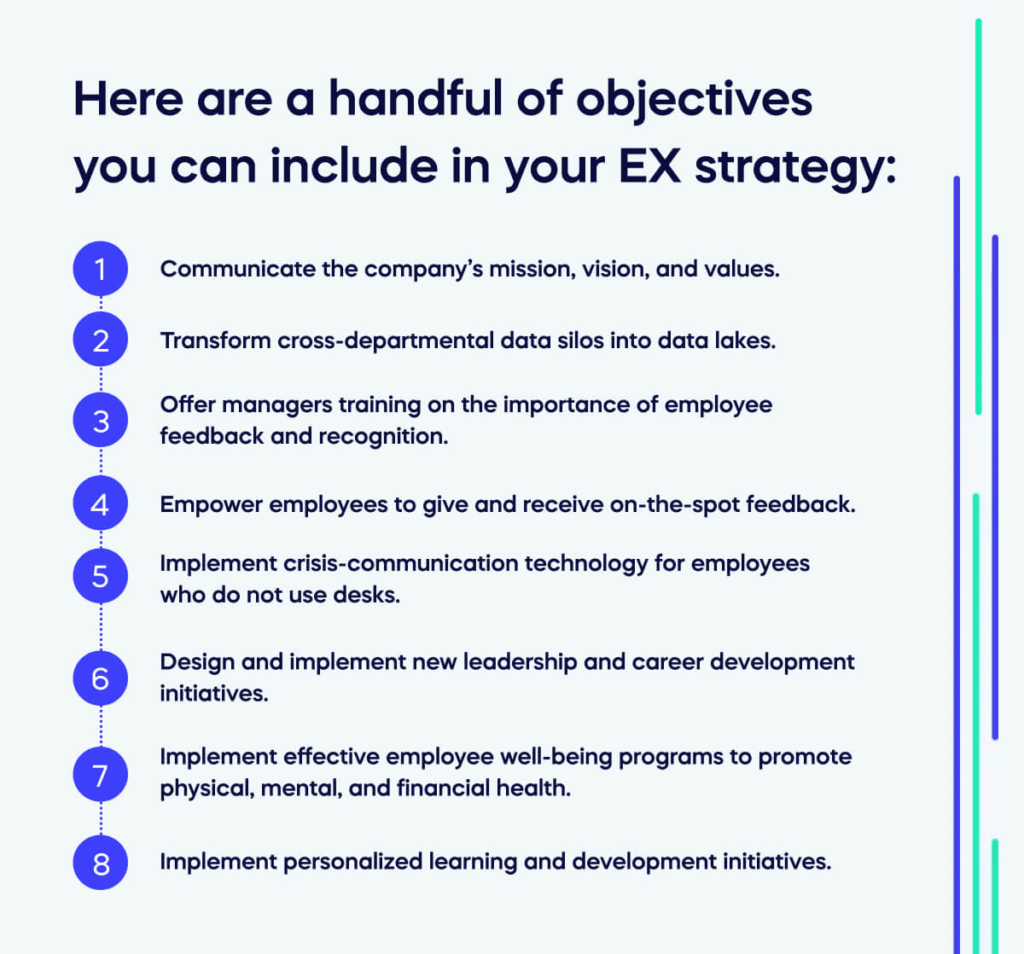
Here are a handful of objectives you can include in your EX strategy:
- Communicate the company’s mission, vision, and values.
- Transform cross-departmental data silos into data lakes.
- Offer managers training on the importance of employee feedback and recognition.
- Empower employees to give and receive on-the-spot feedback.
- Implement crisis-communication technology for employees who do not use desks.
- Design and implement new leadership and career development initiatives.
- Implement effective employee well-being programs to promote physical, mental, and financial health.
- Implement personalized learning and development initiatives.
4. Define your employees’ technology and workplace needs
Get employee feedback on their role and their satisfaction level with the technology the organization provides for them to complete tasks. Also, ask if they desire technology they would prefer to use to optimize their performance.
Technology plays a crucial role in an employee’s day-to-day job performance. From the user interface to mobile devices and desktop computers, it enables employees with the tools necessary for them to achieve their goals more efficiently.
The ideal way to analyze your employees’ current work experience is by listening and conversing with them. Organize focus groups or employee surveys that ask thought-provoking questions such as:
- Does our company culture align with your values and beliefs?
- Do you feel like directions from your manager are straightforward to follow?
- How would you rate your relationship with your manager out of five?
- Are you satisfied with the current offering of career development initiatives?
- Do you feel you have access to all the equipment needed to work from home and do your job effectively?
- Do you find technologies that our organization uses accessible and easy to use?
- Is there any other technology that would make your working experience better?
Utilizing modern employee communication solutions that offer mobile-friendly survey capabilities is critical. Collecting employee feedback, particularly from those more challenging to reach, can be daunting for organizations.
5. Develop employee journey maps
Organizations can use the design thinking methodology to comprehend their people’s journey better. Deloitte Human Capital Consulting articulates it perfectly: “By studying and listening to employees, you can identify new ways of streamlining their work while also increasing productivity, performance, and engagement.” This initiative is achievable through employing tools like journey mapping or empathy mapping.
6. Identify significant experiences (acquired through employee observation and feedback)
As part of their journey, it is essential to identify the key moments that are most meaningful for each employee persona. While some may be motivated mainly by remuneration, others may prioritize career development opportunities more.
Companies who want to stay ahead of the curve constantly seek input from their staff members. Cisco, IBM, GE, Airbnb, and many others have used hackathons to gather ideas and invent fresh methods for performance management, workspace design, advantages & disadvantages systems, employee training programs, and rewards. This co-creation strategy allows employees to participate in developing the “ideal” employee experience.
7. Prioritize personalization
Crafting an employee experience strategy entails designing personalized experiences in the workplace, which involves identifying key employee personas. Technology has a critical role in ensuring these specialized experiences are delivered effectively.
Personalized engagement apps, communication solutions, and productivity tools can significantly impact an individual’s working experience. Despite this, HR technology is still not offering desirable consumer-level user interfaces. Poor personalization leads to low user adoption rates for current workplace programs, so ensure you offer as much personalization at possible.
One of the best ways to implement personalization through technology is by using a digital adoption platform (DAP) There are many exemples in the tech industry of how DAPs have transformed enterprises. IBM used a DAP to boost its retention rate by 6x, resulting in 80% revenue growth.
Examples of successful employee experience strategies
Examples make the outcomes of employee experience strategies more visible. Here are two examples of these strategies that were successful for the employees and the organization, from SAP and HP.
SAP
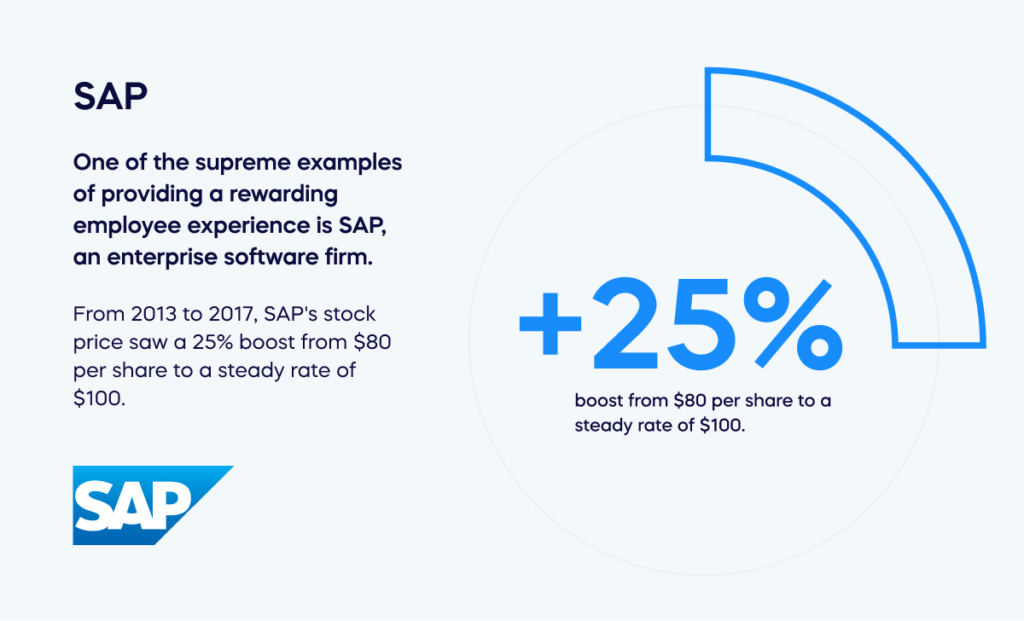
One of the supreme examples of providing a rewarding employee experience is SAP, an enterprise software firm.
- From 2013 to 2017, SAP’s stock price saw a 25% boost from $80 per share to a steady rate of $100.
- Through their unwavering commitment to elevating employee experience, they proudly secured a spot on the Best Place To Work In the list in 2013.
SAP’s exponential growth occurred due to its commitment to the employee experience. Allowing employees increased autonomy and prioritizing their development enabled greater organizational engagement and efficiency.
HP
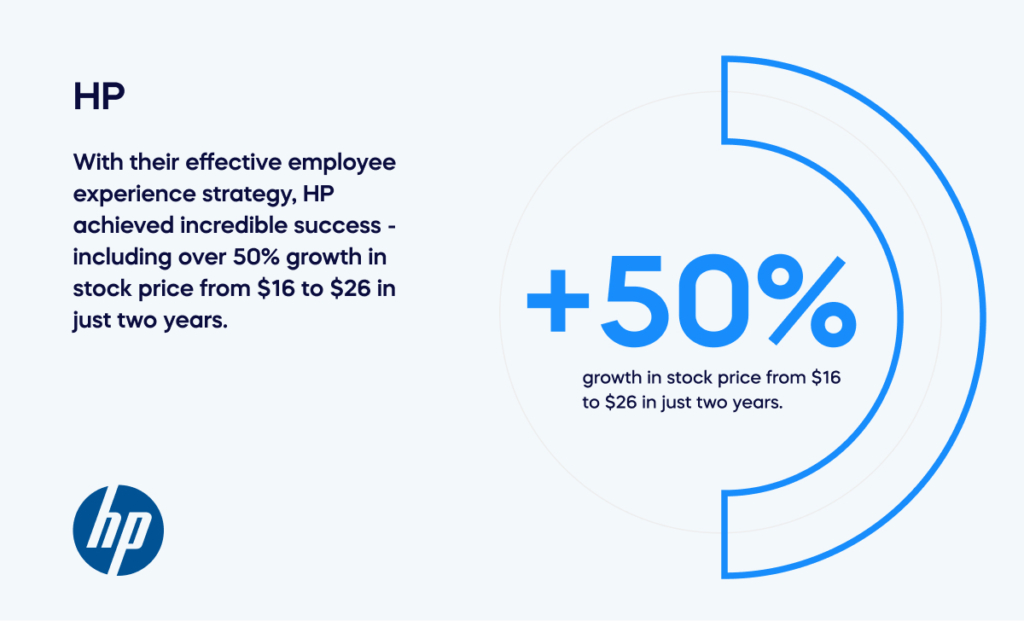
With their effective employee experience strategy, HP achieved incredible success – including over 50% growth in stock price from $16 to $26 in just two years.
- HP repositioned its attention to the growth potential and coaching of its personnel.
- They launched a training and development program for all their staff members to ensure their employees flourished and that their healthcare centers remained up-to-date.
- Introducing strategies in their workplace created a vibrant atmosphere for their personnel.
- In return, the employees commit to diligently boosting the business’ revenue.
In these two examples, we can see how successful employee experience strategies can lead to increases in revenue as organizations continually seek to enhance employee experience.
Leverage employee feedback to optimize their experience
By implementing a strong employee experience strategy, businesses can flourish and build a more productive workplace with a healthy culture. Today’s workforce is more competitive than ever, and creating a sustained competitive advantage through employee engagement is essential. By following the seven steps above, employers can effectively plan, manage, and measure their employee experience, leading to retention and high performance.


